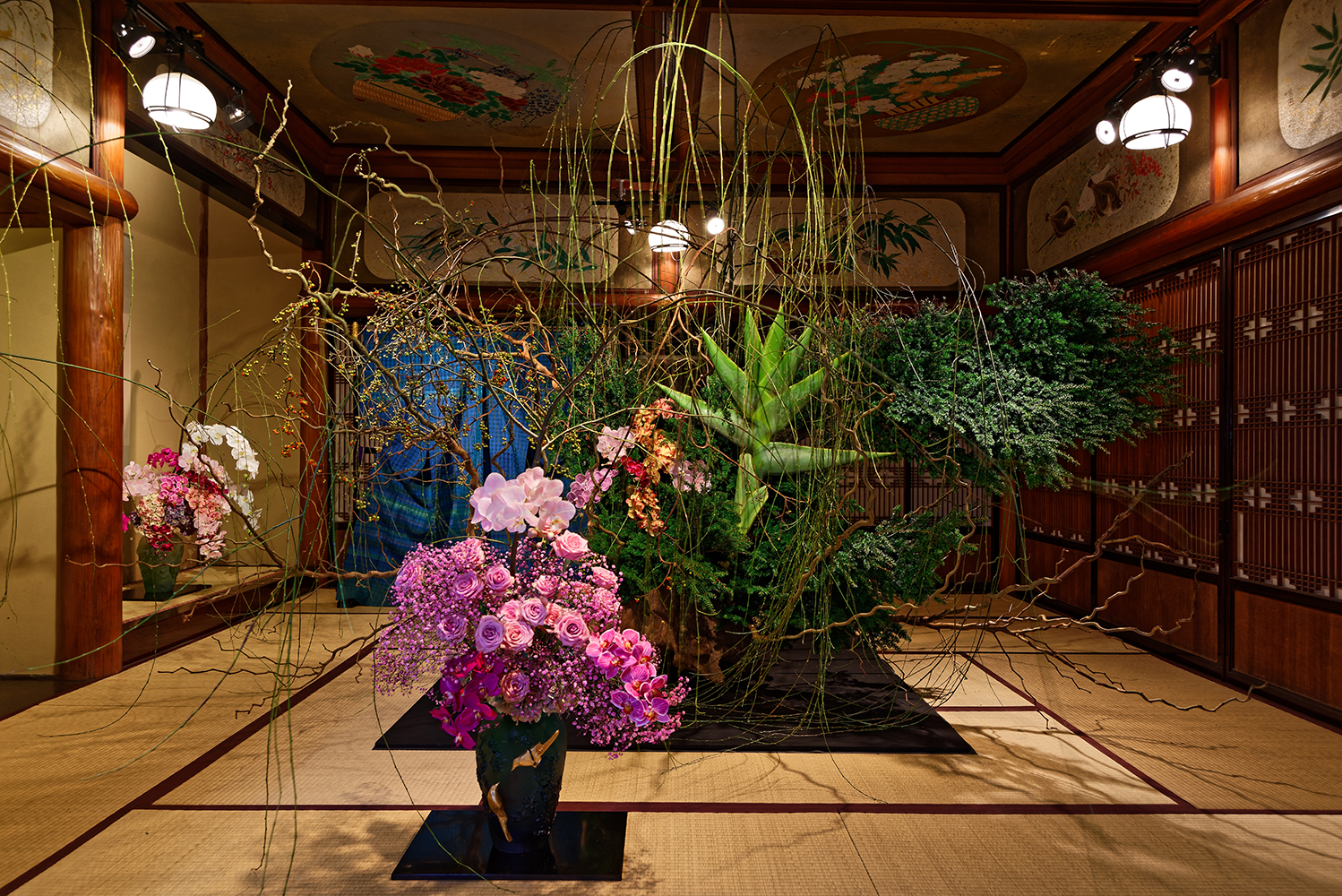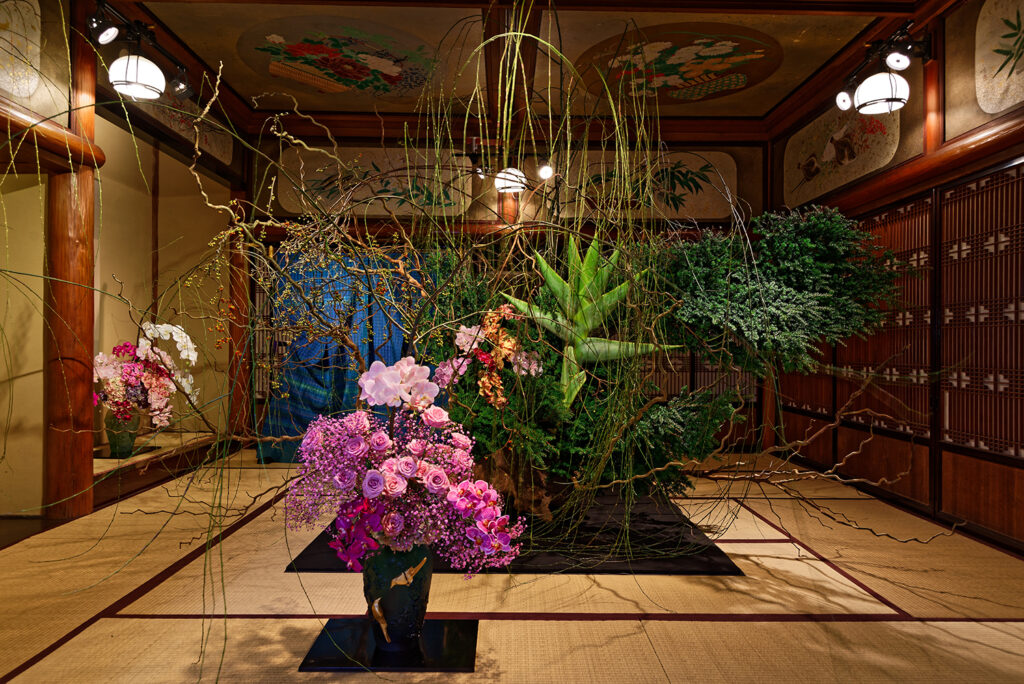
Shogo Kariyazaki, an ikebana artist who discerns the individuality of flowers and elevates their beauty, sometimes in vessels and sometimes in spaces. The memories of the garden he cultivated in his childhood, the cycle of life embedded in the soil, and the fusion with historical architecture. And the once-in-a-lifetime works born from the accumulation of countless moments—. The flowers, given life by the ‘hands that weave beauty,’ shimmer with the brilliance of life, igniting a quiet passion in the hearts of those who behold them. With boundless freedom and unwavering sincerity, Karyazaki continues to challenge new forms of expression, conversing with flowers and resonating with space. Beyond the boundaries of ikebana, he relentlessly explores the universal essence of beauty. I would like to gently step into this journey in search of the essence of beauty that never fades, even as times change.
Q: When you saw the previous issue of “GIANNA”, you noticed the bold patterned open-collar shirt. Are there moments when you feel the intersection of fashion and ikebana aesthetics?
My favourite clothing brand is Paul Smith. The reason is that they create many garments with floral prints. Before the pandemic, I would fly directly to London and stock up on clothes at local shops. Paul Smith is truly a creator. There is no such thing as ‘this is complete’ or ‘this is the end.’ I feel the same way—I must continue to evolve forever. Driven by the desire to keep creating new things, I have lived until the age of 66.
Q: Even with all your achievements, you still feel there is more to do.
I’ve never felt a sense of accomplishment. I’ve had the opportunity to work on many large-scale projects, but when I’m creating a piece, I’m so absorbed in arranging the flowers that I don’t even realise when it’s finished. The moment it’s completed, it becomes a thing of the past. And immediately, my mind turns to the future, thinking, ‘Next, I want to create something different,’ or ‘Something even more amazing.’ If I’m satisfied with it at that moment and think, ‘Yes, it’s complete,’ then that’s enough for me. I don’t dwell on the past, and I don’t care much about others’ opinions. I’m grateful for the many compliments I receive, but I always feel a bit awkward about them. In that sense, I may be a bit of a special person.
Q: In 2023, you will celebrate your 40th anniversary in ikebana. Could you tell us about your first experience of noticing the beauty of flowers?
My father is from Kagoshima Prefecture and my mother is from Nagano Prefecture. Neither of them were the eldest children, so they didn’t have to inherit the family home and came to Tokyo. The two of them met in Ginza, and that’s where I was born. When I was a child, we lived in a public housing complex in Nerima Ward, Ishijima. It was a row house with two connected units, and there was a large garden where my parents planted various plants. There were always flowers blooming throughout the year, and looking back now, I realise how rich an environment I grew up in. I started helping out by imitating them, and grew up as a gardening enthusiast.
Q: What kinds of plants did you grow back then?
When I was in first grade, I was growing roses. After the Golden Week holiday in May, the rose I had carefully nurtured finally bloomed. I went out to the garden early in the morning and saw the rose flower. I was so happy that I rushed to call my mother, saying, ‘Mom, the rose has bloomed!’ But then my mother came with scissors and cut the rose off. Ignoring my surprise, my mother wrapped the rose in newspaper and said, ‘Take it to school.’ I went to school feeling puzzled and gave the rose to my teacher. The teacher carefully unwrapped the newspaper and placed the rose in a milk bottle as a decoration. It was still early in the morning, and the classroom was filled with a sleepy atmosphere. Some students were rubbing their eyes, others had red cheeks… But as soon as they saw the rose, they all sighed in unison, ‘Ah, it’s beautiful.’ My mother must have wanted to share the beauty of the rose with these sensitive children. When I realised that, I felt very proud of my mother.
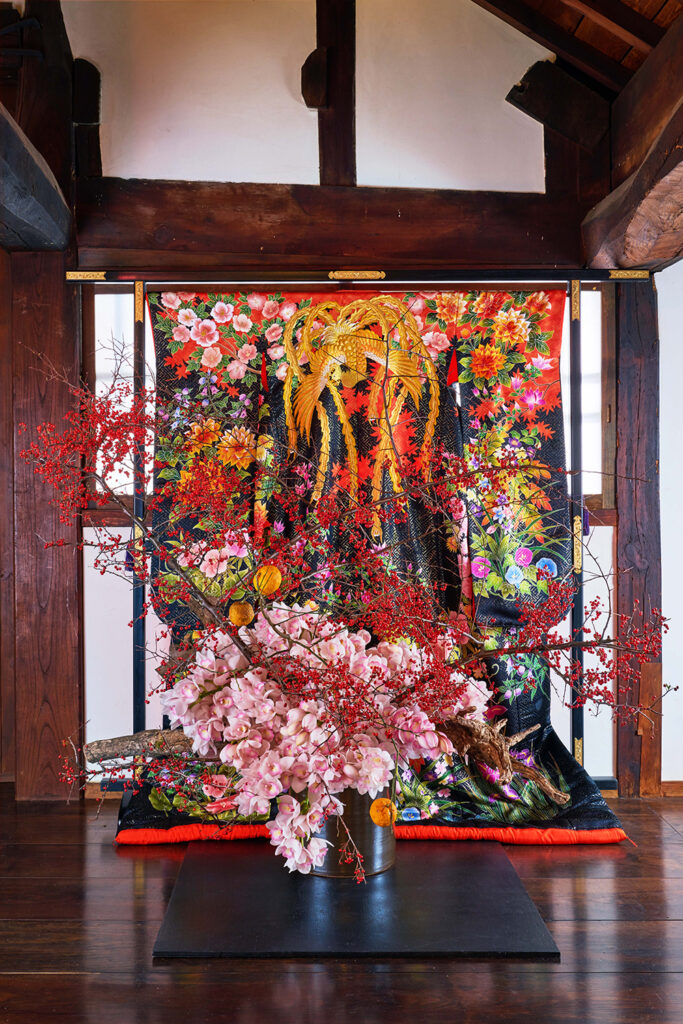
Q: Thank you for sharing such a wonderful story. Mr. Kariyazaki, who grew up as a gardening enthusiast, began ikebana when he was a university student, correct? What was the turning point for you?
After graduating from university, I joined an apparel company, but I felt that I wasn’t suited for that world and quit after three months. However, I had no clear future plans, so I worked part-time at a hamburger shop and a supermarket while contemplating my next steps. Then my father passed away. I felt deeply depressed, thinking, ‘I couldn’t do anything to repay my parents.’ Even while working part-time jobs, I continued ikebana and frequently visited galleries in the city centre. I had always wanted to hold a solo exhibition at a gallery, but with a part-time job paying 360 yen per hour, it was impossible. Renting a gallery in Ginza for a week would cost tens of thousands of yen. Faced with this harsh reality, I was feeling defeated when my mother said, ‘Use this,’ and handed me the money she had been saving for her retirement. Though hesitant, I used that money and held solo exhibitions at galleries in Kanda and Ginza three or four times a year. At that time, I realised that simply arranging flowers wouldn’t have much impact, so I came up with the idea of using soil.
Q: Why did you focus on soil?
Soil is the origin of plants. If you plant a seed, it sprouts, flowers bloom, fruit ripens, and after it withers, the seed grows again. It’s a cycle of rebirth. It was thanks to my parents, who cherished their garden, that I was guided onto the path of flowers, and there was also a sense of apology towards my father, whom I couldn’t repay while he was alive. As I continued to hold solo exhibitions using soil as a material with various themes, critics began to visit. Opportunities to be featured in the magazine “Art Review” gradually increased, and I began to gain attention as a young contemporary artist. I was invited to participate in exhibitions organised by museums and also began taking on projects involving flower displays, spatial design, and interior design.
Q: Did you start receiving offers to appear on television around that time?
It all started with my appearance on the variety show ‘Takashi’s Anyone Can Be Picasso’ in 1997, which led to offers from other programmes as well. Over the next 30 years, I appeared on numerous television programmes. One that stands out in my memory was when NHK invited me to visit Monet’s garden in Giverny to mark my 50th birthday. The documentary, which was compiled into a 90-minute programme, followed me living with the gardener for five days as I expressed myself. It’s a programme I still want to watch myself.
Q: You have created many dynamic works that utilise the entire space, but how long does it take you to complete a single work?
My work is very fast. Thanks to my experience in various jobs, I am quick to make decisions. No matter what people say, I know what is good and what is bad, and what I like and what I don’t like. When I am unsure, I decide it’s no good and move on to the next thing. I can finish a solo exhibition in a day or two. My quick decision-making applies not only to choosing flowers for my works but also to buying a house. I decided to buy a villa in Karuizawa immediately after hearing the details over the phone, without even seeing the property.
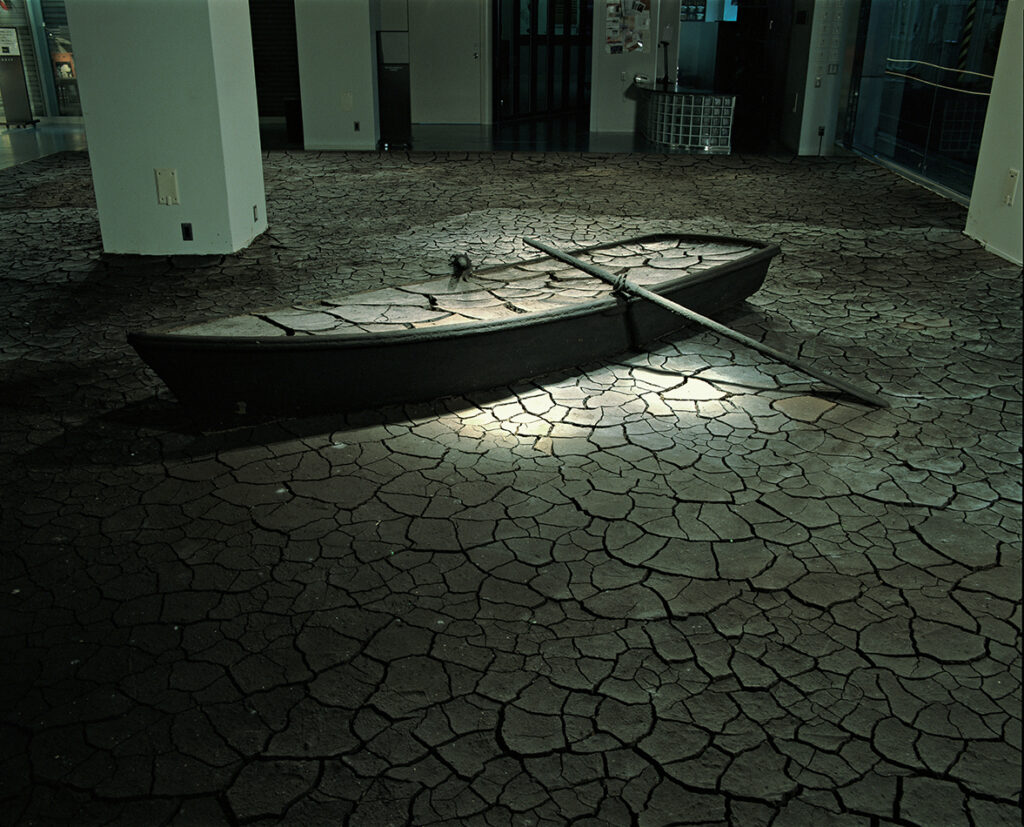
Q: It is your keen sense of beauty that allows you to make decisions based on intuition. You are also holding a solo exhibition series called ‘Challenging Historic Buildings,’ which is a collaboration between flowers and buildings. Could you tell us what sparked your interest in architecture?
The original reason was that my father worked in the architecture field. He collected blueprints, floor plans, and photo albums of former nobleman’s residences, so I naturally came into contact with such things from a young age. My parents loved travelling, and showing me shrines, temples, and castles across the country also laid the foundation for my interest in architecture.
Q: When arranging flowers in large spaces like historical buildings, how do you balance the flowers with the empty space to create your work?
Rather than simply showcasing my own work, I aim to create an arrangement that enhances the beauty of the space itself. It’s about highlighting the space while also expressing my own vision. In a sense, it’s about achieving a “harmony of beauty.” Sculptures and paintings are created in a studio and then transported to an exhibition space, but ikebana involves combining materials on-site and blending them with the space to create something new—that’s where the true essence lies. I think the process of creation itself is completely different from other art forms. The space, the flowers, the vase, and myself. I cherish the encounter between these four elements and elevate them moment by moment.
Q: At Meguro Gajoen (now Hotel Gajoen Tokyo), you held a solo exhibition titled ‘The World of Ikebana Artist Shogo Kariyazaki’ for 17 years until 2016.
At the time, it was an annual event, and many people visited. The ‘Gyosho no Ma’ room at Meguro Gajoen is surrounded by coloured wood carvings and Japanese paintings, and the transom features an original design by Ozaki Chikuhou (Five Festivals) in vivid colours. To bring out the beauty of this space, I arranged flowers in vivid colours that complemented the bluish-purple of the irises and the red of the autumn leaves.
Q: What is the common thread that runs through your work, whether you are arranging a single flower or designing an entire space?
My philosophy is that ‘the power of flowers is conveyed regardless of the size of the work.’ The only difference between a single-flower arrangement and a work that fills an entire space is the amount of time it takes to create. For example, at my solo exhibition held at the Japanese garden ‘Yushien’ on Daikon Island in Shimane Prefecture, I used 200 pieces of 3.6-metre-long timber to create a large work measuring 5 metres in height and 10 metres in width. On the other hand, there are also works that use only yatsude leaves and a single dahlia. Both are ikebana by Shogo Kariyazaki, and my mindset remains the same.
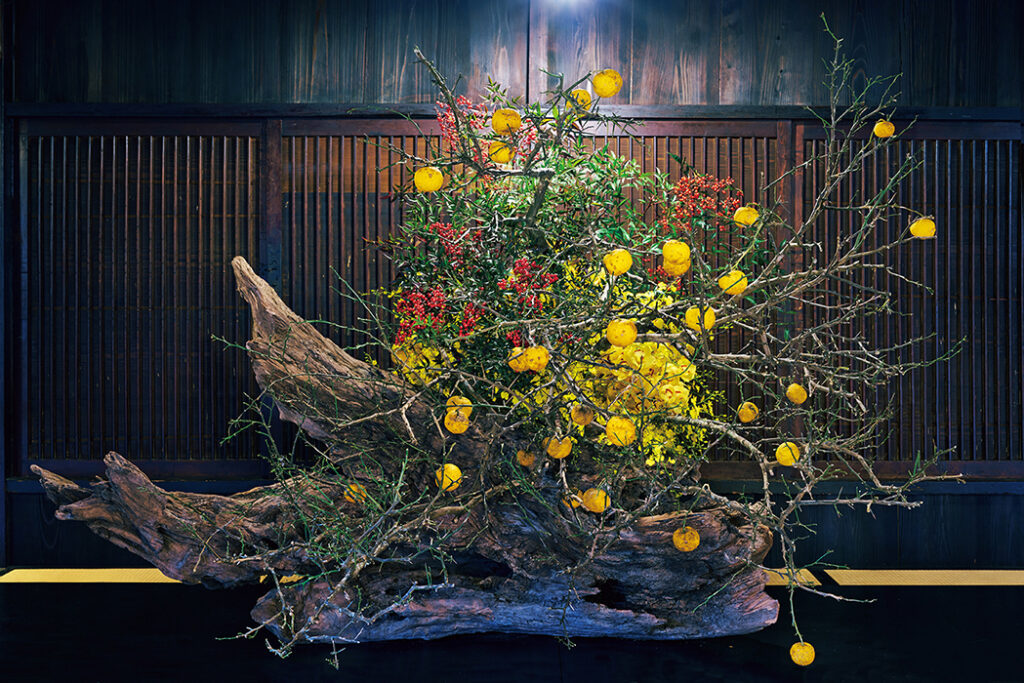
Q: Earlier, you mentioned that you want to keep creating new things. Where do you draw inspiration for your works?
Travel, architecture, and seasonal plants. Lately, I’ve also been inspired by beautiful stories from BL dramas and the like.
Q: When you travel, what kinds of places do you visit?
When I travel, I always visit old buildings and gardens. Recently, I was deeply moved by the Tairyu Sanso in Okazaki, Kyoto. I was overwhelmed by the beautiful building and garden that preserve Japanese traditional culture. I love Kyoto, so whenever I have time, I hop on the Shinkansen and explore various places.
Q: You have worked with a variety of floral materials over the years. Are flowers eloquent or silent to you?
Eloquent. No two are the same, and each flower has its own personality. Encountering such unique floral materials is a miracle, a gift from heaven. By adding my own touch, I create new beauty. That’s the work I do.
Q: What do you think about when arranging flowers?
It’s like asking the flowers, ‘How about this?’ Flowers don’t speak, but when you arrange them, you can sense their desire to be seen in a certain way. I don’t deny that; I arrange them honestly and naturally. So, I don’t start with a preconceived plan of what I want to create. I identify the individuality of each flower and make the most of its qualities. Then I combine it with other materials and add my own touch.
Q: It’s like having a session with the flowers.
Flowers are alive, so they change moment by moment. Ikebana is an ‘art of the moment,’ a once-in-a-lifetime experience. Only those present can feel it, and it evokes various emotions. In life, there are few moments when you can experience such a feeling. I think it’s a very luxurious thing.
Q: How do you view the value of ‘fresh flowers’ in the digital age?
I often say, ‘Flowers are vitamins for the soul.’ Even if you live a modest life, simply placing a single flower in the cup you use to brush your teeth can moisturise the space and nourish your soul. For example, in a war zone, debris is scattered everywhere, and the ground is covered in dirt. In such an environment, people’s hearts become barren, and they lose the ability to feel anything. In such a barren land, the mere blooming of a bud can evoke a sense of the breath of life. I believe such a sensation is particularly important in today’s era.
Q: Many people likely draw energy from your work. Are there any new challenges you wish to undertake in the future?
I want to delve deeper into the world of Japanese aesthetics. I want to create a space that evokes the ‘aesthetic of austerity’ found in alcoves and tea rooms, and arrange a carefully selected single flower to create a new kind of beauty. The world of Japanese aesthetics is truly profound. It is something you pursue until the end of your life, and there is no concept of completion. That is why I believe it is important to continue generating new ideas.
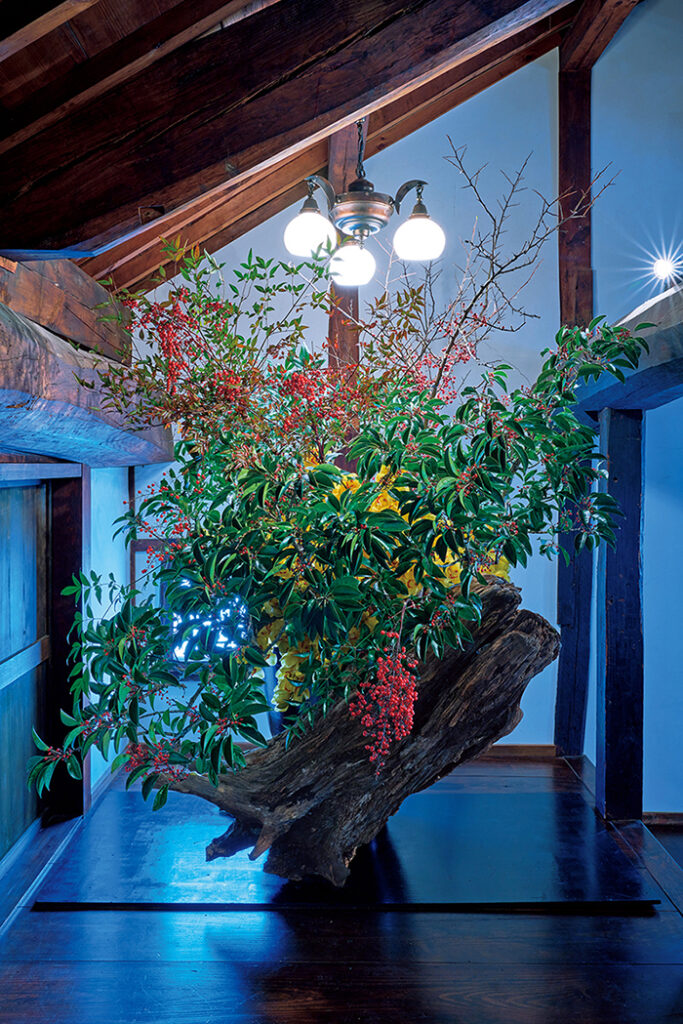
Q: About the featured works
2018 Shogo Kariyazaki Solo Exhibition 11th ‘Ikebana – Creating a Beautiful Future’ Work Photography: Shinya Masuda The red-fruited nandina branches are boldly arranged with an awareness of the space. In the centre, an elegant yellow cymbidium orchid is arranged, and at the foot, a large driftwood is skilfully balanced, creating a work that integrates natural beauty and traditional architecture. This work exudes a sense of inclusiveness and tranquil beauty that envelops the entire space.
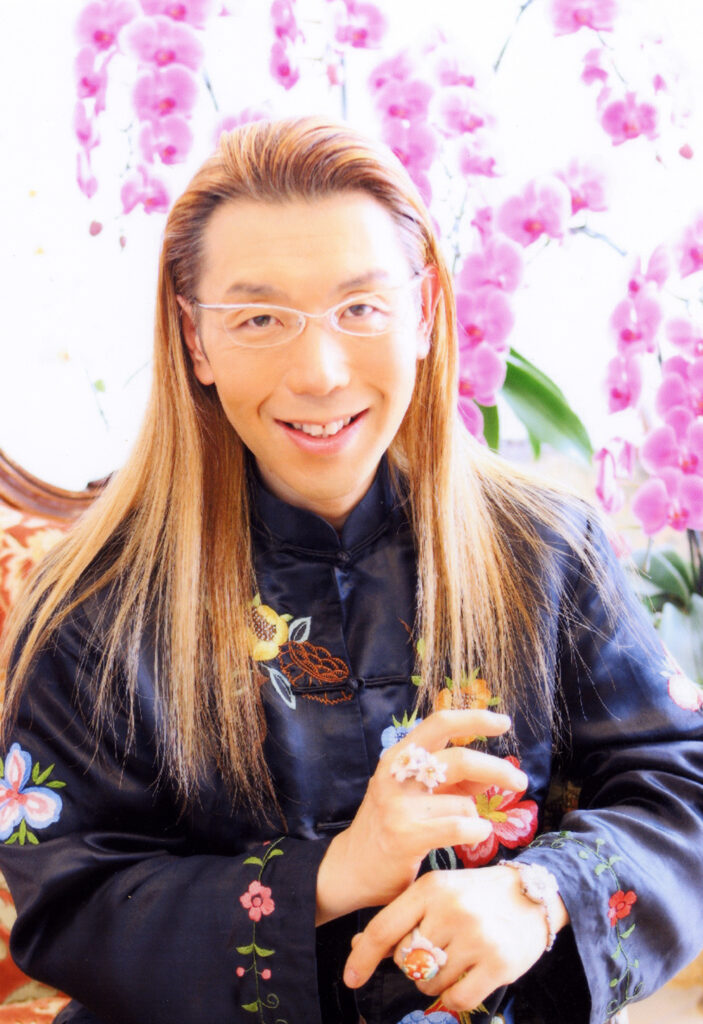
PROFILE
Flower Arranger / Director of ‘Shogo Kariyazaki Flower Arrangement School’ Shogo Kariyazaki
Born in Tokyo. Known for his unique sense of colour and delicate yet dynamic style, he is described as ‘a person with hands that weave beauty.’ He has been involved in numerous projects, including floral arrangements for welcoming foreign dignitaries to Japan, stage decorations for the Emperor’s reign anniversary ceremony, the creation of a welcome monument for the G20 Karuizawa summit, and the production of a flower exposition. He has served as the Japan-France Exchange France Tourism Goodwill Ambassador and the Netherlands Tulip Ambassador. He was also recognised by the Guinness World Records for the ‘world’s largest display of corsages’ using live orchids. He designs and produces kimono, glassware, coffins, and urns, and has held solo exhibitions titled ‘Challenging Historical Buildings,’ which feature collaborations between flowers and architecture, at World Heritage Sites, national treasures, and important cultural properties both domestically and internationally.
Translated with DeepL.com (free version)

